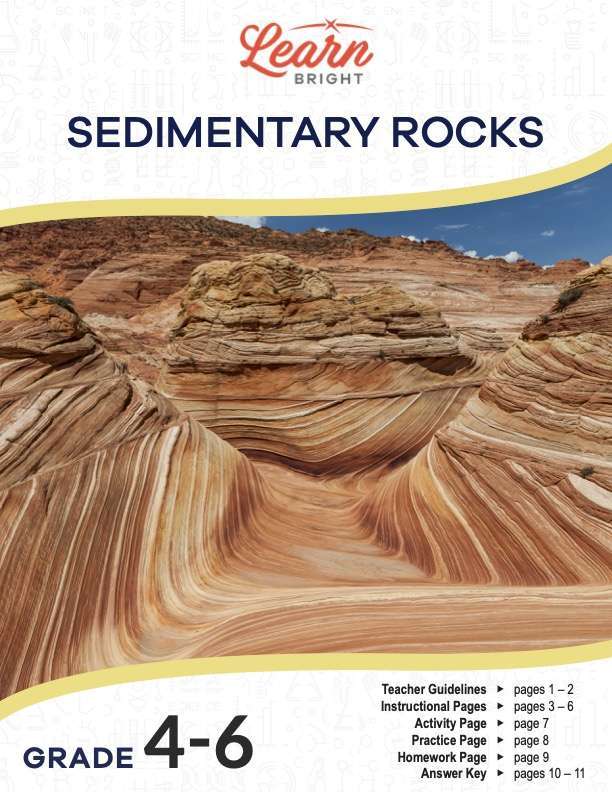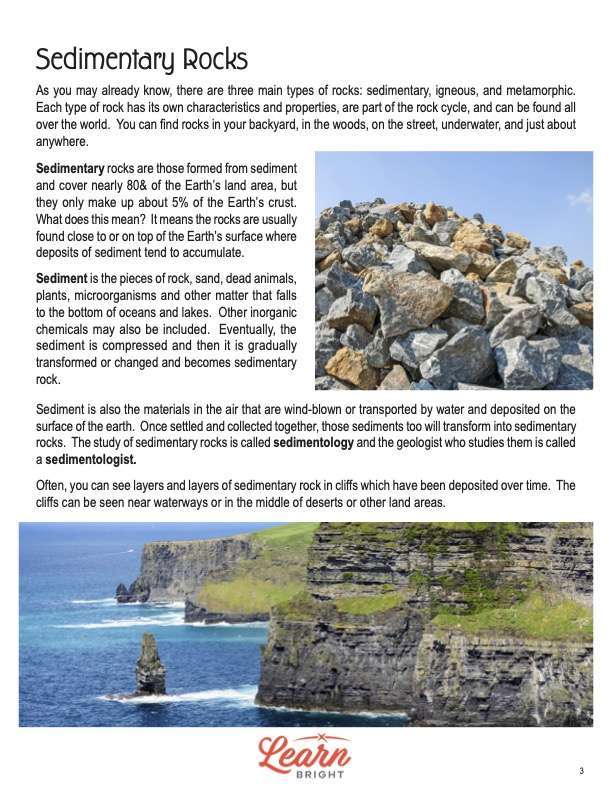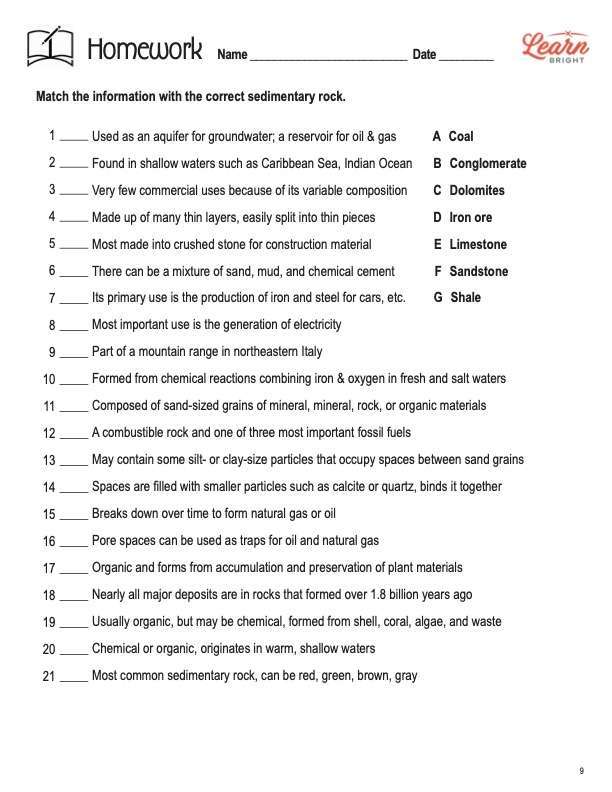Description
What our Sedimentary Rocks lesson plan includes
Lesson Objectives and Overview: Sedimentary Rocks dives deeper into this type of rock and how it forms during the rock cycle. Students will learn which rocks fall into this category. They will see many examples and learn about their traits. By the end of the lesson, students will be able to identify sedimentary rocks easily. This lesson is for students in 4th grade, 5th grade, and 6th grade.
Classroom Procedure
Every lesson plan provides you with a classroom procedure page that outlines a step-by-step guide to follow. You do not have to follow the guide exactly. The guide helps you organize the lesson and details when to hand out worksheets. It also lists information in the yellow box that you might find useful. You will find the lesson objectives, state standards, and number of class sessions the lesson should take to complete in this area. In addition, it describes the supplies you will need as well as what and how you need to prepare beforehand.
Options for Lesson
There are many suggestions in the “Options for Lesson” section that you could incorporate into the lesson if you have time or want to extend or adjust it. One suggestion is for students to write poems or stories about the formation of a sedimentary rock from the perspective of a piece of sediment. Another idea is to obtain different rocks and have students identify each one based on what they observe and what they learned. You could also plan a “Rock Week” during which you teach about all the types of rocks, including this lesson. One other option is to invite a geologist or rock collect to speak with the class and answer their questions.
Teacher Notes
The paragraph on this page provides a little more information on what to expect out of this lesson plan. It suggests teaching this lesson in conjunction with others that relate to rocks or geology in general. The blank lines on the page are for you to write down your thoughts as you prepare.
SEDIMENTARY ROCKS LESSON PLAN CONTENT PAGES
What Are Sedimentary Rocks?
The Sedimentary Rocks lesson plan contains four pages of content. Students will discover that rocks formed from sediment account for nearly 80% of the earth’s crust. This is largely because deposits of sediment tend to accumulate close to or on top of the earth’s surface. Sediment can include pieces of rock, sand, dead animals, plants, microorganisms, and other matter that falls to the bottom of oceans and lakes. It may also include inorganic chemicals. Eventually, sediment compresses and gradually transforms or changes into a rock.
Geologists that study the various kinds of this specific rock are sedimentologists, which means the study of these rocks is sedimentology. Sedimentary rocks often appear in layers, such as those you can see in cliffs. The layers form when sediment deposits in the area and becomes rock over the course of thousands of years.
Through the process of consolidation, each layer gets squeezed and compressed over time and becomes solid. Cementation is another process that occurs after consolidation. This process happens when dissolved mineral components deposit in the spaces between the different layers of sediment. As a result, the sediment sticks together, forming the rocks that eventually create the layers.
The lesson explains that many quarries of unconsolidated deposits exist, where people remove sand and pebbles for use in the construction industry. Consolidated sand can transform into one type of very hard sedimentary rock that we call sandstone. All sedimentary rocks can further change due to water, heat, or extreme pressure.
Kinds of Rocks
Students will next learn about the three kinds of sedimentary rocks. Geologists classify the rocks according to the different processes involved in how they formed. One process occurs when solid sediment sweep down from the land. Then wind and water move the weathered and eroded pieces away through transportation.
Another process happens as wind and water deposit sand grains in water or when pieces of shell or other materials sink to the bottom of a body of water. The last process involves chemicals. The chemicals in a solution, such as acid rain or other precipitation, dissolve materials. Geologists classify the three kinds of sedimentary rocks—clastic, chemical, organic—according to these processes. Clastic rocks form from mechanical weathering debris. Chemical rocks from from dissolved materials from precipitation. Organic rocks form from the accumulation of plant and animal debris.
The lesson outlines several of the most common rocks in the sedimentary class. These include shale, sandstone, conglomerate, limestone, iron ore, dolomite, and coal. Students will learn what these rocks consist of and look like, as well as some of their common uses. The lesson provides a chart that outlines each kind of rock.
Example Stones
Sandstone, for instance, is clastic and comprises mostly sand-sized grains of mineral, rock, or organic materials. They can sometimes contain silt or clay particles as well that occupy the spaces between the grains of sand. Besides construction, people use sandstone as an aquifer for groundwater or as a reservoir for oil and natural gas.
Another common stone is limestone. This type of rock is usually organic, but it can be chemical as well. It comes from shell, coral, algae, and waste and forms in clear, shallow, and marine waters. If chemical, it forms by precipitation of calcium carbonate. Most limestone exists in shallow waters, such as the Caribbean Sea, Indian Ocean, or Gulf of Mexico. People generally use it as construction material or as a road base.
Another cool rock is iron ore. This is a chemical rock that forms when chemical reactions combine iron and oxygen in fresh and salt waters. Iron ore contains two iron oxides: hematite and magnetite. Nearly all major deposits are in rocks that formed over 1.8 billion years ago. Its primary use relates to the production of iron and steel for cars, furniture, tools, bicycles, and much more.
Coal is another common organic sedimentary rock that forms from the accumulation and preservation of plant materials. Students will discover that they would most often find coal in a swamp-like environment. Coal is a combustible rock and accounts for one of the three most important fossil fuels. It provides a source of heat and energy, and people most often use it to process various products.
Key Terms
Here is a list of the vocabulary words students will learn in this lesson plan:
- Sediment—pieces of rock, sand, dead animals, plants, and other matter that fall to the bottom of oceans and lakes
- Sedimentology—the study of sedimentary rocks
- Sedimentologist—a geologist who studies sedimentology
- Consolidation—a process by which different layers of rock squeeze and compress over time and become solid
- Cementation—a process that occurs when dissolved mineral components deposit in the spaces between different layers of sediment and end up sticking together
- Clastic rock—a rock that forms from mechanical weathering debris
- Chemical rock—a rock that forms from dissolved materials from precipitation
- Organic rock—a rock that forms from the accumulation of plant and animal debris
SEDIMENTARY ROCKS LESSON PLAN WORKSHEETS
The Sedimentary Rocks lesson plan includes three worksheets: an activity worksheet, a practice worksheet, and a homework assignment. Each of these helps solidify students’ grasp of the material and content they learned throughout the lesson. You can refer to the guidelines on the classroom procedure page, which outline when to hand out each worksheet.
ACROSTIC POEM ACTIVITY
Students must create an acrostic using the letters of the word “sedimentary” for the activity portion. First they will think of a word for each letter and put it on a poster board. Next, they will add color and images to the poster as well. They can either draw the pictures or find them online or in other resources. Tell them to be creative!
FILL IN THE BLANKS PRACTICE WORKSHEET
The practice worksheet provides a word bank of vocabulary words and a list of 15 statements. Students must fill in the blanks with the correct term based on the lesson. Then they have to answer two more questions at the bottom of the page.
SEDIMENTARY ROCKS HOMEWORK ASSIGNMENT
For the homework assignment, students must match statements to the rock they describe. The options are the seven kinds of rock that they learned about during the lesson. There are 21 total statements. Students will use each type of rock more than once.
Worksheet Answer Keys
The last couple pages of the lesson plan document are answers keys for both the practice and homework worksheets. The correct responses are in red so that it is easy to compare them with students’ responses. If you choose to administer the lesson pages to your students via PDF, you will need to save a new file that omits these pages. Otherwise, you can simply print out the applicable pages and keep these as reference for yourself when grading assignments.









